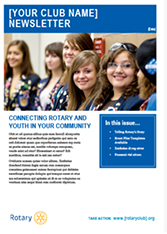Club Newsletters: an effective engagement tool

A good club bulletin speaks to its audience…club members, associates, corporate, government and community partners, as well as Friends of Rotary. It serves to inform, educate, and even entertain. And, importantly, a good club bulletin is the voice of the club itself, promoting the club’s culture, its activities, and its purpose.
The club bulletin is an extension of, and adjunct to other club promotional mediums, such as the website and social media platforms. However, a bulletin has the advantage of being able to reach each audience member proactively by being delivered personally and in a timely fashion.
However, today with so much information flooding our email inboxes, the key to a successful club bulletin is in its ability to engage its readership.
Building a Reputation
People read bulletins when they know it contains interest and value. Our time is precious, so we all want to spend it knowing we are gaining in some way, and when we know the bulletin is delivering this, we will continue to read it, and even look forward to doing so.
Content
Content should help build a sense of pride, responsibility and connection within its readership. It should educate, inform and motivate readers, and provide tips to help members achieve their goals, maintain and improve club performance, and encourage others to connect with Rotary.
The bulletin doesn’t have to be a big production, but articles should be descriptive, relevant and succinct with urgent items in front.
Recognise member achievements, and include summaries of project successes. Short member biographies will help all members get to know one another. Ask Board members, committee chairs and project leaders to submit articles. Use a lot of names. Don’t forget to include articles about your wider audience…corporate and community partners, as well as Friends of Rotary.
Recognise Rotary monthly themes and include relevant items. Share information about what is happening in Rotary at a District, Zone and International level, which members may otherwise miss.
Include important administration matters such as Board decisions and other key aspects of club business. Summarise progress against club goals. Include a schedule of events, and encourage attendance of friends, associates and your wider connections. Emphasise the need to promote membership.
Invite different members to submit written items. It spreads the workload and encourages personal development. And always have someone other than the writer proof-read articles.
Make sure to include club contact and meeting details, the website address and social media platforms.
The Club President should be responsible for content approval, whilst the editor’s role is to coordinate and publish articles that support and promote the club and its priorities.
Appearance
The bulletin is a visual medium. Use graphics, models and pictures (remember the adage: “A picture tells a thousand words.”), but also ensure logos, colours, themes, etc. are in line with Rotary’s brand guidelines (visit the Brand Centre at My Rotary).
Finally, look at the layout. Is text easy to read? Is the layout visually appealing? Is there variety between text and graphics, short grabs and longer (but not too long) articles?
Critically review your current bulletin and see what you can do to make positive changes.
Timing
There is no rule to say a bulletin has to be produced weekly. Smaller clubs might find a monthly bulletin achieves a satisfactory result, whereas larger clubs with a lot happening might find a weekly publication is appropriate. Find what suits.
A successful bulletin will have an all-of-club involvement. It will be fun to produce and give voice and above all, interest to its readers.
Acknowledgements Rotary District 9800 September 2021